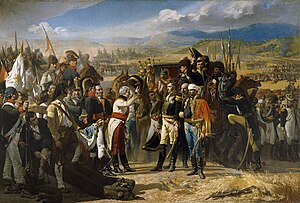Battle of Bailen
| Battle of Bailén | |||||||
|---|---|---|---|---|---|---|---|
| Part of the Peninsular War | |||||||
 The Surrender at Bailén by José Casado del Alisal. Oil on canvas. Museo del Prado. |
|||||||
|
|||||||
| Belligerents | |||||||
|
|
|
||||||
| Commanders and leaders | |||||||
|
|
|
||||||
| Strength | |||||||
| 21,130 regulars 3,300 cavalry 24 guns |
27,110 regulars and militia 2,660 cavalry 25 guns |
||||||
| Casualties and losses | |||||||
| 2,200 dead 400 wounded 17,635 captured |
243 dead 735 wounded |
||||||
The Battle of Bailén was fought in 1808 by the Spanish Army of Andalusia, led by Generals Francisco Castaños and Theodor von Reding, and the Imperial French Army's II corps d'observation de la Gironde under General Pierre Dupont de l'Étang. The heaviest fighting took place near Bailén (sometimes anglicized Baylen), a village by the Guadalquivir river in the Jaén province of southern Spain.
In June 1808, following the widespread uprisings against the French occupation of Spain, Napoleon organized French units into flying columns to pacify Spain's major centres of resistance. One of these, under General Dupont, was dispatched across the Sierra Morena and south through Andalusia to the port of Cádiz where a French naval squadron lay at the mercy of the Spanish. The Emperor was confident that with 20,000 men, Dupont would crush any opposition encountered on the way. Events proved otherwise, and after storming and plundering Córdoba in July, Dupont retraced his steps to the north of the province to await reinforcements. Meanwhile, General Castaños, commanding the Spanish field army at San Roque, and General von Reding, Governor of Málaga, travelled to Seville to negotiate with the Seville Junta—a patriotic assembly committed to resisting the French incursions—and to turn the province's combined forces against the French.
...
Wikipedia
